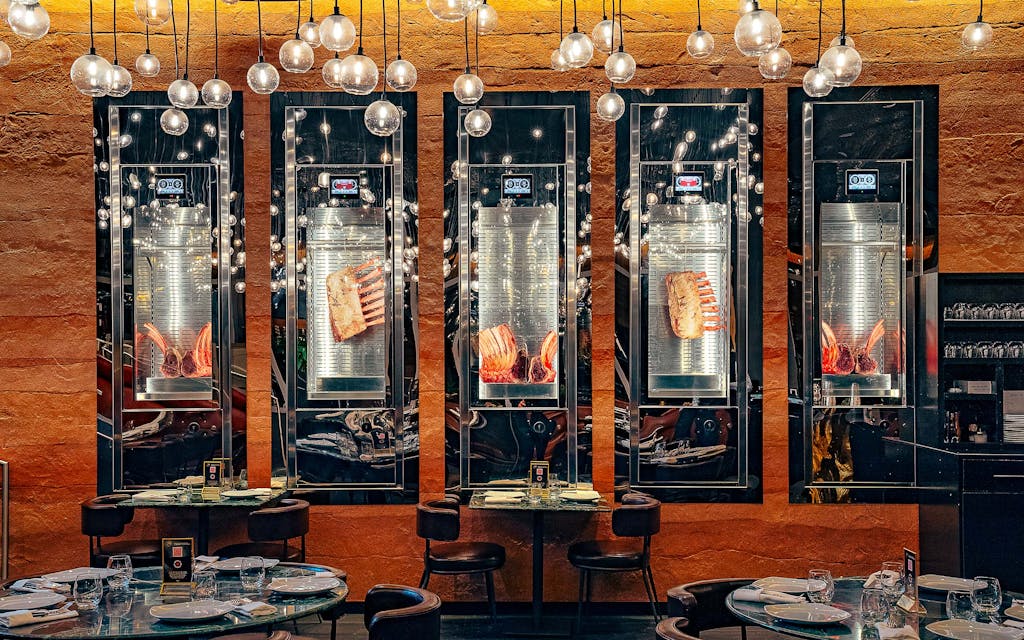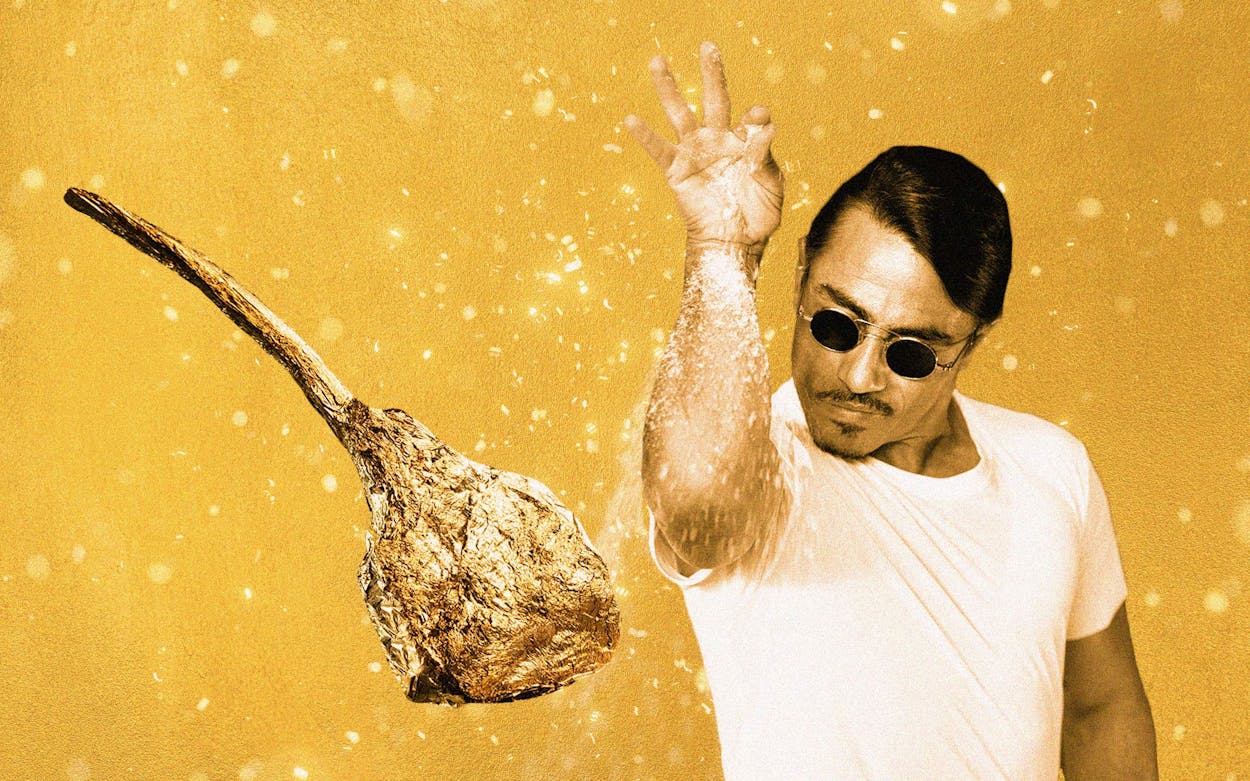Dallas has spawned a generation of steak dynasties. Multiple national chains originated in Dallas: Bob’s Steak & Chop House in ’93, III Forks in ’98. Big D is also home to industry legends such as John Tesar’s Knife and the old-money Al Biernat’s, each with sister locations in the Metroplex. Dallas has been home to the massively successful Pappas Bros. Steakhouse for 23 years. Addison, to the north, is home to the first location of the Fogo de Chão chain outside of Brazil. There’s also the inimitable Nick & Sam’s in flashy Uptown, where chances are high of spotting a Cowboy or Maverick on any given night of the week, and the chances of seeing aspiring fashion models are even better.
Festal by nature, these purveyors of prime beef have never been a place to go for a budget meal. Texas Monthly executive editor Patricia Sharpe called these cherished institutions the Übersteakhouses in her 1997 guide “The Elite Meat to Eat,” in which she writes that “sales at upscale beef palaces began to rocket” in the mid-nineties after the success of Outback Steakhouse and with the American public’s growing “lust for beef.” Americans began seeking out steak dinners at home and in restaurants. “About the only thing that isn’t a time warp is the check: $30 to $60 a person,” Sharpe wrote.
Today, finding a steak with sides for less than $60 is possible at only a few of the aforementioned Übersteakhouses—maybe during lunch, or for an eight-ounce filet, or with Fogo de Chão’s $53.95 “churrasco experience” with limitless cuts and salad bar. Sixty dollars is now a starting point. There are few Groupons or kids-eat-free nights; instead, this is a saturnalian experience of affluence served with hunks of grilled red meat in a dining room full of glitterati. Rather than just a place to be fed, the Dallas steakhouse is a place to be seen, in person and now online. Alongside celebratory birthday and anniversary dinners, those who are seemingly rolling in money—or wish to pretend to be for one night—go to partake in the ceremony of paying inordinate prices. It’s dining as a sport, and the recently opened Nusr-Et, with its $1,100 gold foil–wrapped tomahawk steak, is the new medal of honor.
To be fair, the steak isn’t always quite that expensive. Without the edible (and flavorless) gold, it’s a relative bargain at $275. If you’re lucky, chef Nusret Gökçe, better known as Salt Bae, will be in town to slice the steak with his scimitar blade and season it from a proffered bowl of salt, which he sprinkles down his shiny, oft-memed forearm. After expanding from the Middle East to Miami and Las Vegas, the bawdy butcher’s Dallas outpost opened in March. The gold-wrapped steak isn’t about the flavor, however; it’s about the ’gram. (A company spokesperson, who declined to comment on the chain’s high prices, refers to Nurs-Et’s dishes as art pieces.) Instagram and Twitter made Salt Bae famous, and diners purchasing his stunt are undoubtedly posting for their own share of the likes.
Among those willing to spend the money is Dallas-based production company owner Kelly Bryant, who says she regularly goes to Nick & Sam’s and enjoys traveling to eat at new places. She booked a reservation to visit Nusr-Et in its second week, after seeing a TikTok video of the salting phenomenon.
“[Salt Bae] has this energy and presence,” she says. “You can’t help but notice him. He walks around the room, and you can’t help but look.” She ordered the $300 gold-covered cheeseburger, since she was told it would bring Salt Bae to the table. After cutting it in silence, he held a burger half up to the camera behind her shoulder and slowly and dramatically uttered one word: “juicy.” “We died laughing,” she says. “The whole thing is a production, even the drinks, the cocktails—it’s all about show and presentation.”
Bryant remembers the total bill for the three in her party being around $1,800, but to her it was worth it because she got to see Salt Bae, she had fun, and life is about experiences. “Eating a good meal is worth the investment,” she says. “I understand the value of a dollar and the hard work that goes into it, and this is the area I choose to invest in to enjoy life.”

Brian Taylor, a professional body builder from Watauga, visited Nusr-Et two months after it opened in Dallas, but Salt Bae was at his Beverly Hills grand opening at the time. Taylor and his wife spent nearly $900 for a burger, some lamb chops, two sides, a bottle of wine, and a bottle of water (not even the water is complimentary). He considers the evening a success because there was a “nice vibe,” his wife enjoyed it, and the food was made even better by the service and presentation. “I think it’s worth it if you’re one of those that can afford to spend a few hundred and not miss it,” he says.
Gökçe may have taken Dallas steakhouse prices into the realm of impossibility, but the cost for top-shelf steak in the city was already improbable. Before the golden tomahawk came to exist, Nick & Sam’s founding chef and co-owner Samir Dhurandhar released the Dirk in 2017, in honor of his regular customer and friend, Mavericks star Dirk Nowitzki. The steak is a 41-ounce bone-in prime filet that today sells for $265. The same year, Georgie by Curtis Stone, a Highland Park steakhouse named as one of the most beautiful new restaurants in America, scandalized food media and diners when it opened with a $390 42-ounce bone-in ribeye from Australian producer Blackmore Wagyu. (The farm’s program raises calves on their mother’s milk in a pasture for six months, before they meet their fate as either breeders or eventual food.)
Eddie Sullivan, co-owner of Riscky’s Steakhouse, which has been stationed in the Fort Worth Stockyards since the 1920s, says he doesn’t ever see himself spending thousands on a steak. “I don’t see how a regular person or a family of four can afford it,” he says. “But of course you have your Dirks out there.” He’s kept his steaks with sides under $50 because, as he sees it, “volume cures all ills.”
Georgie co-owner Stephan Courseau asks and answers the most pertinent question about the gold leaf–wrapped tomahawk: “Does the gold make it taste better? I can’t answer that,” he says. “[At Georgie], we connect to farmers more than gold diggers.”
Chef Dhurandhar of Nick & Sam’s came from New York to lead that Gatsbyesque steakhouse 22 years ago; he is no stranger to glitz, glam, and big-city prices. About Nusr-Et, however, he says, “I don’t get it. I’ve been two times. The food is good, but it’s overpriced. And I’m an expensive restaurant—but I don’t think I gouge people.” Nick & Sam’s offers a large selection of prime steaks, sourced from top-of-the-line Allen Brothers. It’s also one of very few restaurants in the nation offering certified Kobe beef. “Our steaks aren’t cheap,” Dhurandhar says, “but if you start with a good cut, there’s very little you have to do after that.”
As at Nusr-Et, people come to Nick & Sam’s for more than the upper-crust steaks. The well-heeled and deep-pocketed are there for the roaring twenties experience with complimentary caviar; cocktails and desserts served in mysterious, attention-drawing puffs of dry ice; and Willy Wonka–like batons of cotton candy with LED flashing lights. “People go out to eat to have fun with family and friends,” Dhurandhar says. He’s discovered that if you offer a product that diners enjoy, “people are willing to spend the money.”
The cuts at Nick & Sam’s and Georgie by Curtis Stone might seem like stunt steaks at first glance, but for many who want quality beef in a refined ambiance, these menus have budget-friendlier options that won’t be repeatedly hashtagged and TikToked. If a stunt steak ever truly existed in Texas before Salt Bae arrived, it would be the 72-ounce offering at the Big Texan Steak Ranch, which opened in Amarillo on Route 66 in 1960. The restaurant’s original aim was to lure cowboys away from the stockyards with steaks, barbecue, nickel beers, and check-cashing services. Co-owner Bobby Lee says the 72-ounce-steak challenge that’s now livestreamed on YouTube started with his dad, who wanted to capitalize on the customers who bragged about how much meat they could eat. Five-dollar bets turned into the 72-ounce challenge—eat it all with a baked potato and salad in under an hour and it’s free. In spite of the gimmicky challenge, Lee still backs the steaks. “Call us a tourist trap, call us what you will, but we’ve kept the quality. We would’ve died a long time ago if not.”
The Big Texan now feeds around 500,000 people a year, with noteworthy guests that have included actor Billy Bob Thornton, various Bushes, Jimmy Carter, and Elvis Presley—not to mention the record-breaking competitive eater Molly Schuyler, who ate three 72-ounce steaks, three baked potatoes, three rolls, three salads, and three shrimp cocktails in twenty minutes. And that, my friends, is a steak stunt.






